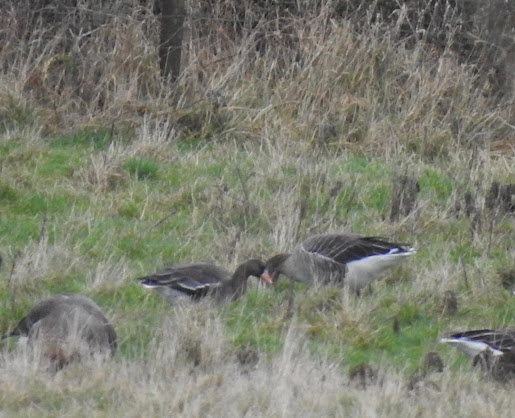I had a clear plan for today. I was going to go to Mappleborough Green Flash to see if there were any waders there (Morton Bagot currently looking unsuitable due to a shortage of mud). Then a spanner was inserted in the works. Mark Clarke posted a photograph on Whatsapp of a swimming White-fronted Goose at Arrow Valley Lake.
I assumed this was the immature I had found at Morton Bagot at the turn of the year, which was subsequently reported at Upper Bittell. I hadn't been to see it at Bittell, but a chat with Mark Islip at the Cattle Egret twitch (just me and him), led me to understand that it was turning up occasionally at Arrow Valley Lake and was starting to show a more advanced plumage.
So I diverted to have a look at it. I found it easily on the shore at the yacht club, and had no hesitation in identifying it as a White-fronted Goose which was moulting towards adult plumage.
 |
| White-fronted Goose |
To me, the white fore-crown combined with largely unmarked belly (there are just a couple of black feathers starting to come through) and the relatively faintly barred mantle were consistent with this being a first year bird even though the white "front" is now adult-like.
However I later received a text from an experienced Worcestershire birder which I initially thought was querying the bird's provenance, but in fact implied that it may not be a pure-bred White-fronted Goose. The argument being that a first-winter bird should not have so advanced a white forehead, while an adult should show more black on the belly. I agreed to send him a photograph so that he could forward it to a very experience Goose expert who would look at the bird "properly" (unlike me I suppose).
I thought I'd compare this bird with my more distant shots of the Morton Bagot bird from December.
 |
| The Morton Bagot White-front in December 2023 |
The obvious first question is whether it is even the same bird. The earlier bird appears to have a plainer mantle and looks darker (but it is distant, so the shot is cropped). There is only a hint of white on the forehead. I wish I knew what the Bittell bird looked like (I would imagine the views were also very distant), but the fact it was reported within two days of the Morton Bagot bird's only appearance suggests it should be the same bird.
So what about provenance? Assuming this is indeed a first-winter White-fronted Goose and not an oddly plumage (possibly impure) adult, then I think its credentials as a wild bird are OK despite it turning up at a park lake. My reasoning is that a lost juvenile could easily latch onto a resident Greylag Goose flock, and then just follow them around all winter. Given that young geese learn to migrate by following their parents it might not even be too surprising if it now fails to migrate back to the arctic for the summer.
Nothing's ever simple where birds and birders are concerned.
Anyway I then resumed my original plan and paid my first visit of the year to Mappleborough Green Flash. Walking down the field from the Boot Inn, I heard, and briefly saw, a singing Willow Warbler. Others turned up at Earlswood and Coughton Park today, so spring is definitely here. This was nearly my earliest ever Willow Warbler in the UK (I saw one in the garden and heard two at Draycote on March 25 2005). Also singing was at least five Chiffchaffs and a Blackcap.
I reached the flash and found it much as it had looked last March. I counted 21 Teal, and a pair of Shovelers, before they all became aware of my presence and took flight.
 |
| The Shovelers flying off |
One unfortunate aspect of this site is that it is virtually impossible to see the birds without disturbing them. By the time I reached the largest gap in the trees everything had gone, but I did hear the call of a Little Ringed Plover, and then located it in the gravelly field on the other side of the fence.
 |
| Very poor record shot in the heat haze. It was actually quite warm. |
I then headed for the overspill flash (which dries up readily as spring advances) and found all the Teal and both Shovelers were now there, and so were a pair of Shelducks and a Green Sandpiper. Once again as soon as I got into a position where I might have been able to photograph anything, they all departed.
I also had a site tick. A very distant Red Kite, no longer unexpected around here.
My drive home was accompanied by regular sightings of fluttering Brimstone butterflies. The feel-good factor is back.
PS: The expert, Martin MacGill, has agreed it is indeed an advanced first-winter White-fronted Goose.
No comments:
Post a Comment